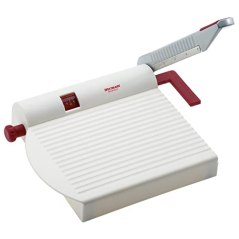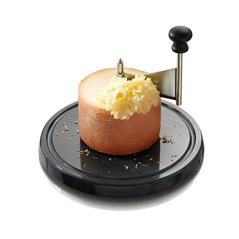
A flexible food slicer with adjustable thickness.
A flexible food slicer with adjustable thickness.
High-quality cheese slicer that can be used on any other foods as well since it uses a blade instead of a wire. Ergonomic aluminum handle makes it easy to use. Easy to clean. Backed by a 5-year warranty.
No locking mechanism so you have to be careful where you store it.

A handheld design for more control.
A handheld design for more control.
A modern and elegant design in a handheld cheese slicer. Adjustable for slices up to 1/4-inch thick. Made for everyday use to replace pre-sliced cheese, so it is durable and comfortable. Heavy-duty roller is easy to use. The one-year warranty has you covered.
Some users note that they have to adjust the wires often as they can loosen with use.

An elegant look for anyone looking for the optimal slicer for entertaining.
An elegant look for anyone looking for the optimal slicer for entertaining.
Measures 5 by 8 inches. Looks more expensive than it is with its white marble base. Included spare wires are a nice bonus for when you break a wire.
Some users note they had to adjust the arm slightly so that the wire slides into the groove when cutting.

Creates lovely, thin cheese curls, but offers little in versatility.
Creates lovely, thin cheese curls, but offers little in versatility.
High-quality product that is fit to be the showpiece on your charcuterie tray. Creates delicate curls out of any hard cheese, or some softer versions if chilled. Includes marble round board, steel pin, and curling knife. Dishwasher safe.
Can only be used with cheese wheels and certain types of cheese.

We recommend these products based on an intensive research process that's designed to cut through the noise and find the top products in this space. Guided by experts, we spend hours looking into the factors that matter, to bring you these selections.

Fine cheese, when spread across a platter or serving tray, makes mouths water. Often, you must slice the cheese yourself. Trying to do this task by hand can be frustrating, especially if your goal is to create evenly sliced pieces for your guests (or you) to munch on. If you’ve got a block of cheese you’d like to serve, you need a cheese slicer.
A cheese slicer can raise any occasion or get-together to the next level. The question is, which type of cheese slicer would serve you best? Should you go with a handheld slicer or one that ships with a cutting board base? Would a wire blade serve you best, or is a metal blade the better choice? How much should you pay for a cheese slicer?
Our buying guide tackles these questions and more. Shopping for a cheese slicer is a piece of cake — or cheese — when you follow our guidelines.

You’ll encounter two types of cheese slicers when shopping: handheld cheese slicers and cutting board cheese slicers.
Handheld cheese slicers: As the name implies, this type of slicer is held in your hand. You slide the blade to carve off slices. The blade may be a sharp wire or something more knife-like.
Cutting board cheese slicers: In this configuration, the slicer is attached to a cutting board. You place the cheese on the board and use the affixed cutter to slice your cheese. A cutting board cheese slicer can add a pleasing aesthetic to a social setting, and these tools tend to be not only easier to use but also safer.
You’ll also find some specialized cheese slicers on the market. For example, there are cheese curlers that only work with cheese wheels. You place the cheese on a platform and rotate a blade on top of it to create thin cheese curls. Some would argue that this appliance is more like a cheese grater than a cheese slicer, but this is a matter of opinion.
Regardless of how often you use it, a cheese slicer should be sturdy enough to hold up over time. Handheld slicers and the cutting elements of board-based slicers should be crafted from stainless steel or another metal that resists rust and corrosion.
The wire cutter is one of the weakest elements on some cheese slicers. If you’re purchasing a wire cutter and want something that’ll last for years, pay close attention to product reviews.
If you want a long-lasting board-based cheese slicer, consider one with a marble or solid wood base. Some bases are made of bamboo or ABS material. These materials may also serve you well, but it depends on the quality of the overall product.
If you’re just using a cheese slicer for yourself or don’t intend to display it, you may not care how it looks. But if you like to entertain, note that a cheese slicer can serve as a focal point on a table full of food. As such, it should look the part.
Board-based cheese slicers have the edge here. In particular, we think board-based slicers made of marble or wood can really deliver a sense of style to your party.
While generally not an issue with handheld cheese slicers, size can be an issue for board-based cheese slicers. The larger the board, the larger the block of cheese you can slice. Also take into account how you plan to store the board when not in use. Will you tuck it away in a cupboard, or will you display it on a counter? Either way, a slicer that’s too big could pose an issue for someone living in tight quarters.
So how big are board-based cheese slicers? They range from a compact 5 x 8 inches to a more robust 8 x 12 inches.
Some cheese slicers feature a knob or other mechanism for altering the thickness of the cheese. In fact, this is a fairly common feature of handheld slicers (less so for board-based slicers). Some of the best handheld cheese slicers can produce paper-thin slices as well as slices that are one-quarter of an inch thick.
The bottom line for any cheese slicer in terms of adjustability: before you buy it, know whether it is adjustable and what range of thickness the slicer is capable of.
Some cheese slicers are dishwasher safe; others should be washed by hand. Manufacturer recommendations vary considerably, so be sure you know how your slicer should be washed before you attempt to clean it.
Even if you are washing your slicer by hand, the process of cutting cheese is not exactly a kitchen-trashing affair, so cleanup should be minimal. Warm soapy water and a kitchen towel should suffice. Just be sure to completely rinse and dry a slicer after washing it.

Material: For board-based cheese slicers, the cutting board is a big consideration. As we’ve mentioned, common construction materials include wood, marble, and ABS material. Each has its advantages.
Shape and design: While cutting boards are usually rectangular, some are round. Most have a cutting wire or blade attached to the board and a groove cut into the board so the blade can completely cut through a block of cheese.
Traction: If you’re worried about safety, opt for a board that features rubber feet on the bottom for non-slip stability. This is especially important if you will be assigning cheese-slicing duty to a younger person.
Whether you select a slicer with a wire or a blade, be sure that it is made of a hardy material like stainless steel. If you purchase a slicer with a wire, check the product specs: some sellers include additional replacement wires with shipment.
The handle should be comfortable to grip and unlikely to slip out of your hand. Furthermore, it should be designed to keep your hand from coming into contact with the slicer’s cutting blade during use.
Inexpensive: The cheapest cheese slicers cost less than $10. These are usually simple handheld slicers that offer little in the way of adjustability or other features.
Mid-range: The average price for a cheese slicer sits in the $15 to $30 range. As price goes up, build quality improves. You’re more likely to find features like adjustability and the addition of extra wires here.
Expensive: You could spend up to $70 for a cheese slicer. These products are often stylish board-based slicers that offer more control over slice width and consistency. You’ll also find specialized cheese slicers, such as those that work with cheese rounds.
A cheese slicer with a blade (as opposed to a wire) can often be used to slice other types of foods, including sausage and vegetables such as cucumbers and lettuce.
Soft cheese can be difficult to slice, even with a high-quality cheese slicer. To make the task easier, try slicing it when it’s cold and firm with a wire blade.
Don’t place a cheese slicer with a wooden cutting board in the dishwasher, as this can cause the wood to warp.
If you slice a lot of harder cheeses, such as cheddar or Swiss, be sure the handle is ergonomic and comfortable. A firm handle could prove painful, even if only used for a short time with hard cheese.

Q. Which is a better cheese slicer cutting board material: wood or marble?
A. Wood exudes a rustic aesthetic, while marble is viewed by some as classical or elegant. Wood is lighter than marble, which may also be a consideration.
Marble does have a few benefits over wood in terms of its surface. Unlike wood, it won’t absorb odors or moisture, and it’s slow to heat up, so your cheese will be less likely to sweat.
Q. How easy are cheese slicers to use?
A. Ease of use depends on the slicer. Handheld models are easier to use if the handle is comfortable. A handheld slicer that adjusts for different cheese thicknesses may be easier to use than one that you hold at different angles to vary the thickness. That said, board-based cheese slicers are often the easiest to use, and thickness tends to be consistent.
Q. Are these cheese slicers for soft or hard cheese?
A. Some work better with soft cheeses like Brie or Munster. Others are more geared towards semi-hard cheeses like Gouda or Cheddar or even hard cheeses like Parmesan or Gruyère. A wire cutter (instead of a blade) can help with cutting soft cheeses, while a handheld slicer with a blade may be more effective at slicing harder cheeses.
The listing of any cheese slicer should detail what types of cheese the slicer can effectively slice.
Get emails you’ll love.
Learn about the products you’re wondering if you should buy and get advice on using your latest purchases.
